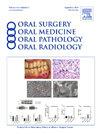Incidental finding of ossification of the vascular pedicle after maxillofacial reconstruction with free fibular flap: case series
IF 2
3区 医学
Q2 DENTISTRY, ORAL SURGERY & MEDICINE
Oral Surgery Oral Medicine Oral Pathology Oral Radiology
Pub Date : 2025-02-04
DOI:10.1016/j.oooo.2024.11.048
引用次数: 0
Abstract
Clinical Presentation
Case 1: An 18-year-old male patient presented to our oral and maxillofacial surgery clinic for implant consultation after having the left mandibulectomy with free fibula flap reconstruction to treat low-grade myofibroblastic sarcoma. The neck was asymptomatic with no significant clinical expansion. One month after the surgery, a panoramic radiograph and a cone beam computed tomography revealed a curved, tube-like calcification inferior to the mandibular surgical region.
Case 2: A 28-year-old female patient presented to our oral and maxillofacial surgery clinic for a follow-up of the right maxillectomy with free fibula flap reconstruction to treat odontogenic myxoma. The cheek and the neck were asymptomatic with no significant clinical expansion. Cone beam computed tomography was taken 4 months after the surgery and revealed a linear, irregularly curved radiopaque entity from the maxillary surgical region to the neck.
Differential Diagnosis
Ossification of the vascular pedicle, peroneal artery atherosclerosis, new bone formation, retained surgical material, including bone fragments.
Diagnosis and Management
The radiographic and clinical findings were consistent with heterotopic ossification of the vascular pedicle. No treatment is required in these cases since asymptomatic.
Conclusion
We present 2 cases with heterotopic ossification of the vascular pedicle after previous segmental maxillectomy and mandibulectomy with the free fibula flap. This condition's exact etiology is variable; tumor-related surgery, trauma, congenital anomalies, and radiotherapy influence it. Glastonbury et al. reported that a modified harvesting procedure by removing the fibular periosteum did not develop flap ossification. Their theory explains it occurs more frequently in younger patients. Essentially, it mimics recurrent tumors clinically, and surgical removal is required when clinical symptoms such as trismus and severe pain occur. Because of its advantage, the free fibular flap is commonly used and the first choice for maxillofacial reconstruction. Knowing these imaging features is critical to differentiate from arteriosclerotic plaque, retained foreign body, or especially recurrence.
求助全文
约1分钟内获得全文
求助全文
来源期刊

Oral Surgery Oral Medicine Oral Pathology Oral Radiology
DENTISTRY, ORAL SURGERY & MEDICINE-
CiteScore
3.80
自引率
6.90%
发文量
1217
审稿时长
2-4 weeks
期刊介绍:
Oral Surgery, Oral Medicine, Oral Pathology and Oral Radiology is required reading for anyone in the fields of oral surgery, oral medicine, oral pathology, oral radiology or advanced general practice dentistry. It is the only major dental journal that provides a practical and complete overview of the medical and surgical techniques of dental practice in four areas. Topics covered include such current issues as dental implants, treatment of HIV-infected patients, and evaluation and treatment of TMJ disorders. The official publication for nine societies, the Journal is recommended for initial purchase in the Brandon Hill study, Selected List of Books and Journals for the Small Medical Library.
 求助内容:
求助内容: 应助结果提醒方式:
应助结果提醒方式:


